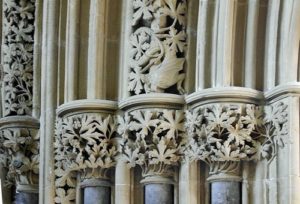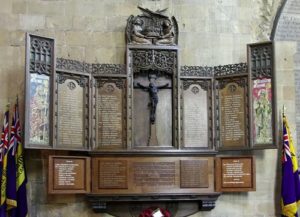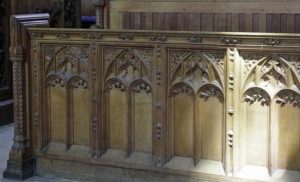Southwell Minster is one of the best Norman cathedrals in the country, ranking alongside Durham and Selby. It is a stunning building with its central square tower and two square towers at the west end. Topped by pyramid spires, these feel continental rather than English. It is worth walking round the outside before going in to admire the rope decoration around the tops of the Norman windows, arcading on the towers and the carved doorways with their chevron carving and carved capitals.
Entry is through the south door which is spoilt by a large display board blocking part of the carving and assorted notices on the benches in the porch. It was impossible to avoid these in a photograph and was a sign of even worse to come…
Behind the nave alter was a huge screen with assorted AV equipment which completely blocked attempts to photograph the nave and east end, as well as destroying the ambience of the building. We assume (and hope) this had been put up for the school children visiting that day and is not a permanent feature. There are also other signs, impediment and ‘clutter’ around the building which get in the way of photographs. The photo permit is £5 which is expensive compared with other places. I have to confess this led to increasing feelings of frustration as I moved around the building.
The building has a long history. There was a collegiate church here in Saxon times, which became the mother church of the southern part of the Diocese of York. In 1108, the Archbishop of York authorised the rebuilding of the small Saxon Minster by a splendid new church which is what is seen today. In the C13th, the Norman choir was replaced by a larger Gothic choir. The chapter house was the last part of the building to be finished in 1300. The pulpitum, the stone screen across the archway between nave and choir was built in 1340.
The Minster escaped relatively unscathed during the Dissolution of the Monasteries and survived the ravages of the Civil War, although parliamentary troops used it to stable their horses.
In 1711 the south steeple was hit by lightening and the wind fanned the flames across the main part of the church. The wooden roof was destroyed, the bells melted and molten lead ran down the walls. Fortunately the fire didn’t reach the choir. By the beginning of the C19th, the building was in poor condition and the spires taken off the west towers. It was restored in the mid C19th and the spires replaced 1880-8. In 1884, the Minster became the mother church of a new diocese and officially became a cathedral, although it is still called a Minster.
It is a glorious building inside with round Norman pillars in the nave with carved capitals and massive round Norman arches separating the nave from the long narrow side aisles. Above are two more rows of round arches. The nave ceiling is wood, the side aisles are stone and vaulted. The nave pulpit is carved with figures of Mary and the Christ Child, a bishop and other saints.
Stained glass is C15th, apart from the huge west window which is modern.
The crossing has powerful round Norman arches with spiral carvings. Above the nave arch is a gilded statue of Christ. Under the chancel arch separating choir from the rest of the church is a beautifully carved stone pulpitum with three ogee arches with crocketed tops. It is even more impressive seen from the choir. Above is the organ.
On the wall of the south transept is a carved wooden triptych with names of eh dead from the First World War.
The choir has pillars made up of several small round pillars supporting pointed arches. Above is another arcade of pointed pillars. Choir stalls have carved fronts and ends. The choir pulpit is also carved with arches and the Virgin Mary holding the Christ Child. Steps lead up to the sanctuary with its simple altar set under tall lancet windows with stained glass. The gilded reredos was designed by Sir Niniam Comper in 1936 and forms a triptych behind the altar. It has painted scenes from the life of Mary Magdalene and other saints.
At the end of the north aisle is a small chapel with an altar and a splendid monument with the figure of a praying bishop.
The octagonal chapter house is down a small passage off the south aisle with an arcade of pillars with carved capitals and ogee arches with small carved heads between them. On the east wall are small inset stained glass windows.
A lovely open arch with carved capitals with leaves leads into the chapter house. Round the walls is a stone bench with a blind arcade of ogee arches with triangular crocketed carving above them. Again the capitals on the pillars are carved with leaves. A notice by the archway explains that people come from all over the world to look at the carvings. What we hadn’t expected to see was the chapter house being used as an art exhibition.
So, to sum up – it is a fantastic building and the quality of the carvings is superlative. The building merits 5* easily. It is just unfortunate that it was spoilt for photography by all the extraneous ‘clutter’. I did email the minster after our visit but never received a reply.
The church is open daily from 8am-7pm in summer or 8am until dusk in winter. There is a large public car park across the road. The building is fully accessible for wheelchair users.










